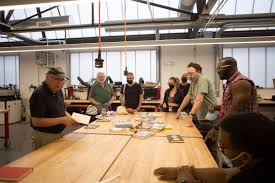Ph.D. in Art and Design: Introduction, Admission, Registration, Eligibility, Duration, Fees, Syllabus 2024

Introduction:
A Ph.D. in Art and Design is a prestigious academic pursuit that delves deep into the realms of creativity, innovation, and critical thinking within the context of visual arts, design theory, and cultural studies. This advanced degree program aims to cultivate scholars who can contribute groundbreaking research, push the boundaries of artistic expression, and lead transformative projects in various artistic disciplines.
Graduates of this program often emerge as thought leaders, educators, curators, or practicing artists, equipped with advanced theoretical frameworks and practical skills to navigate the complex landscape of contemporary art and design.
Admission Process:
- Submit application form with academic transcripts and letters of recommendation.
- Statement of purpose detailing research interests and goals.
- Portfolio showcasing previous artistic work or research projects.
- Interview with faculty members or admissions committee.
- GRE scores may be required in some institutions.
- Meeting any additional requirements set by the specific program or institution.
Eligibility:
- Master’s degree in a related field (sometimes exceptions are made for outstanding candidates).
- Strong academic background and research skills.
- Demonstrated commitment to the field through previous work or projects.
- Proficiency in relevant languages or software tools may be required.
Completion Time:
The completion time for a Ph.D. in Art and Design typically ranges from 3 to 5 years, depending on various factors such as the nature of the research, the candidate's progress, and the specific requirements of the program. During this time, students engage in rigorous coursework, independent research, and dissertation writing under the guidance of faculty mentors. Additionally, some programs may offer opportunities for teaching experience or internships, which can extend the completion time but provide valuable professional development opportunities. Overall, completing a Ph.D. in Art and Design requires dedication, perseverance, and a passion for advancing knowledge in the field.
Career Opportunities:
- University professor or lecturer.
- Researcher or scholar at museums, galleries, or cultural institutions.
- Independent artist or designer.
- Curator or arts administrator.
- Consultant for creative industries or government agencies.
- Art critic or journalist.
- Entrepreneur in the creative sector.
Syllabus:
- Advanced seminars in art theory and criticism.
- Research methodologies in art and design.
- Specialized courses in the candidate's area of focus (e.g., painting, sculpture, graphic design, etc.).
- Interdisciplinary studies exploring intersections between art, technology, and society.
- Dissertation research and writing.
Internship Opportunities:
- Collaborative projects with museums, galleries, or cultural organizations.
- Teaching assistantships or research positions within the university.
- Residencies at artist communities or studios.
- Internships with design firms or creative agencies.
- Opportunities to participate in conferences, workshops, or exhibitions.
Scholarship and Grants:
- Institutional scholarships or fellowships based on academic merit.
- Grants from government agencies, private foundations, or arts organizations.
- Research assistantships or teaching assistantships with stipends.
- Opportunities for funding through dissertation fellowships or travel grants for conference presentations.
FAQs:
Can I apply with a bachelor's degree instead of a master's?
While most programs require a master's degree, exceptional candidates with extensive experience or exceptional portfolios may be considered.
Are GRE scores mandatory for admission?
It depends on the institution's requirements. Some programs may require GRE scores, while others do not.
Can I pursue a Ph.D. part-time while working?
Some programs offer part-time options, allowing students to balance their studies with professional commitments. However, the completion time may be longer compared to full-time enrollment.
What is the typical class size for Ph.D. students?
Class sizes vary depending on the program and specific courses. In seminars and workshops, class sizes are often small to facilitate in-depth discussions and mentorship.
Is international experience or language proficiency required?
While not always mandatory, international experience and language proficiency can be advantageous, especially for research topics that involve cross-cultural or global perspectives.




